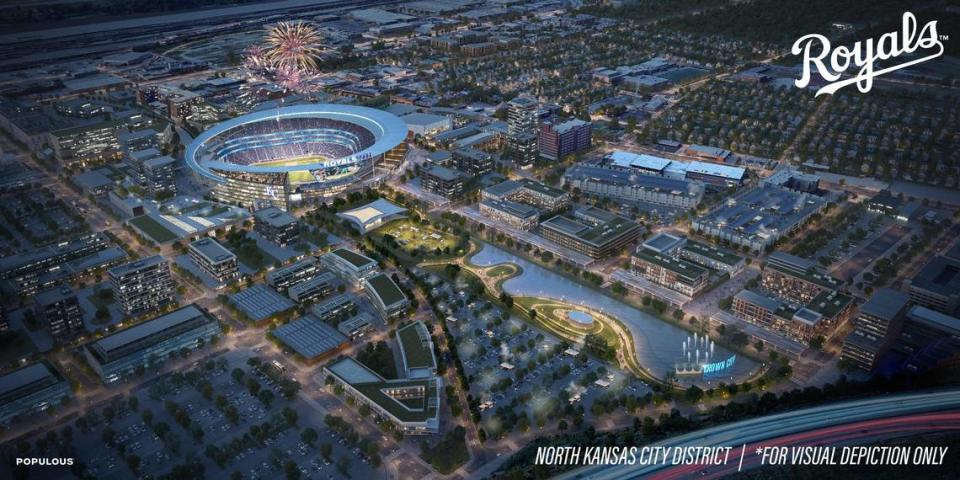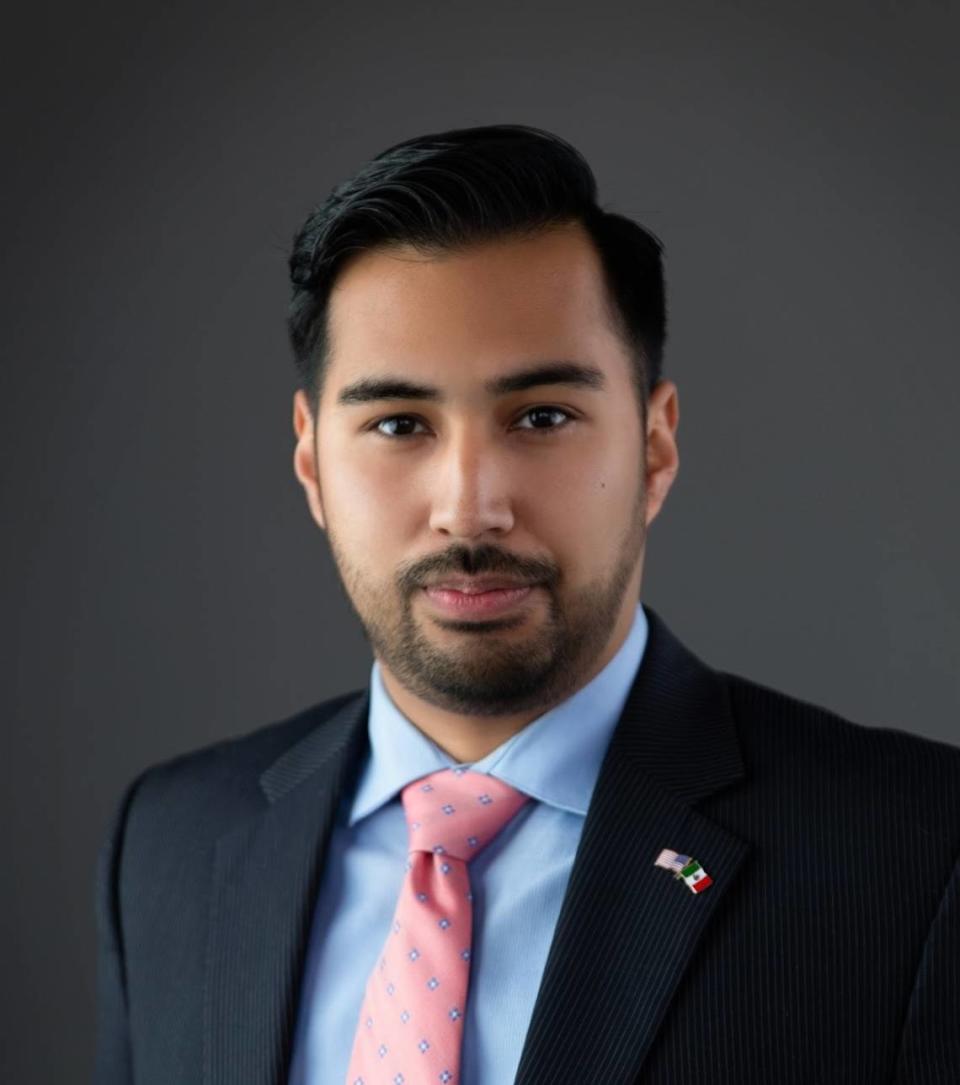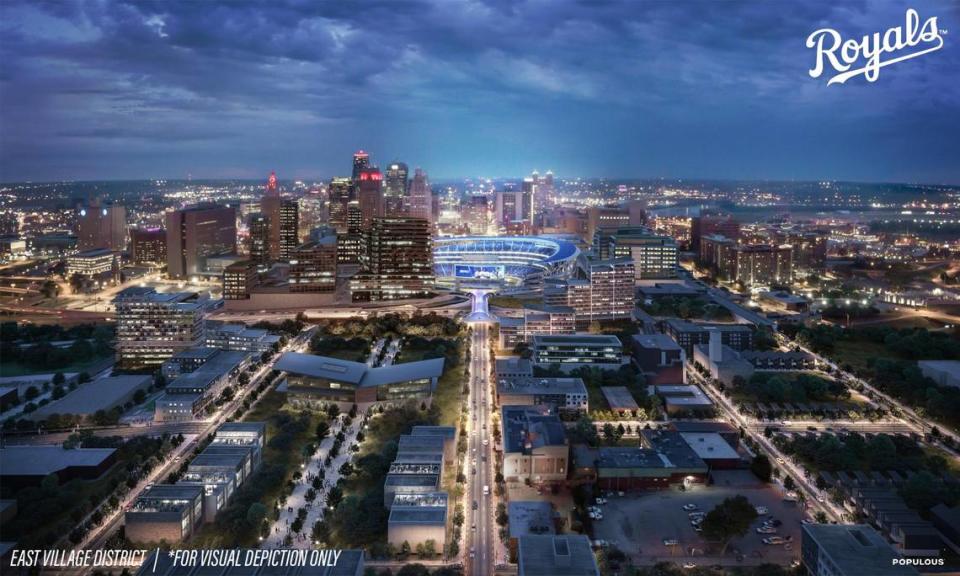‘Straight-up gaslighting.’ Experts question Royals on new stadium’s economic benefits
The Royals, in making their latest pitch for a downtown stadium this week, included projections for how much economic benefit the $2 billion project would bring.
But three national sports economists who study new stadiums and their economic impact say the teams’ numbers are fiction.
Asked by The Star to evaluate the team’s economic study of what a new stadium and adjoining ballpark district development would mean for the area’s economy, all three experts scoffed at the document’s claims. They characterized it as propaganda to support the team’s request for taxpayer support to build the $1 billion ballpark and $1 billion commercial district adjoining it.
“This is not a study; it is simply a bunch of assertions,” said Andrew Zimbalist, professor emeritus of economics at Smith College. “The scholarly studies on the economic impact of stadiums and collateral development do not support the claims made here.”
The experts don’t dispute that there may be benefits to a new stadium — if Kansas City wants to remain a big league city, it has to be willing to pay, or teams may go elsewhere. But the team should be honest and not promise economic returns that may not be reality.
Along with renderings of what the Royals say their new home might look like in downtown Kansas City or North Kansas City, the team this week released a 16-page report outlining the economic boost the ballpark and real estate development would bring the community.
“A new ballpark district can drive economic energy across greater Kansas City,” team consultant Imran Aukil of HR&A Advisors Inc. told reporters at Tuesday’s news conference.
Heavy on photos and graphics, the document contained no underlying documentation to explain the study’s methodology, or support its projections.
That lack of data concerned the economists.
“The numbers look nice, but there is no explanation where they came from,” said professor Michael Leeds at Temple University in Philadelphia.
Among the team’s claims:
▪ The $2 billion stadium/ballpark district investment, split evenly between construction of a 35,000-seat stadium and adjacent commercial real estate development, would create 20,000 jobs across the region.
▪ Those workers would be paid $1.4 billion, and those dollars would be spent in the community, resulting in $2.8 billion in total economic output.
▪ In its first year of operation the stadium and new ballpark district would have the potential to provide $185 million in net new regional economic output, $68 million of which would be increased spending from visitors’ travel to the games and the rest “generated by the new gameday experience and other events.”
▪ The presentation characterizes those benefits being “perpetual,” meaning that they would be ongoing, although it doesn’t say for how many years, creating 600 new jobs across greater Kansas City from increased hotel stays and associated spending.
▪ Finally, the office space created in the adjoining ballpark district would create 2,200 jobs and those workers would be paid $200 million a year, producing a half billion dollars in annual economic output. Annual retail and hotel revenue could be more than $320 million.
Leeds was skeptical of those bullet points, saying that 20,000 jobs from the construction of the stadium/district seemed high to him.
“These jobs will presumably disappear when the stadium/district is built,” he said in an email. “In 2021 the (gross domestic product, a measure of economic activity) of the KC metro area was about $154 billion. This claims that construction of this alone will add 1% to GDP. That seems high to me.”
J.C. Bradbury, an economist at Georgia’s Kennesaw State University, said he “found nothing useful in that document, and I mean in the sense that we don’t know where those numbers came from.”
Like Zimbalist and Leeds, he has long studied the economic impacts that new sports facilities have on local economies, when compared to the ones promised.
“What I’ve seen from the Royals ownership, some of the statements they’ve put out, is that it is very much just straight-up gaslighting,” he said.
HR&A defended its study in a statement to The Star Friday morning:
“We rigorously identified reasonable assumptions around spending and then dig deep and stress tested those assumptions by comparing historical precedents in similar cities as well as industry trends for construction costs, ticket revenue, and other economic drivers.”
The firm added: “When weighing public benefit, it’s worth emphasizing that the Royals will invest $1 billion or more in the project. As Brooks Sherman, Royals President of Business Operations, said in this week’s press conference, you can believe the team will do everything possible to meet or exceed the estimates as that’s what would be best for the Royals and Kansas City.”

The team’s economic impact presentation identified the source of their information as HR&A consulting and IMPLAN, which is software that projects the economic benefits of new stadiums.
IMPLAN is not a data source. It’s a tool.
“That’s like saying, I did this on a calculator. It outputs only what you input into it,” Bradbury said. “That software is often used and often abused.”
Economists have long warned that the inexpensive software can be employed to produce a desired result.
“It is frequently used to confirm an advocacy position of those who commission studies, rather than a search for truth,” according to the abstract of a 2019 academic journal article written by professor John L. Crompton at Texas A&M University.
Legislator isn’t convinced
Jackson County legislator Manny Abarca was also skeptical of the Royals’ numbers. The team will need the majority support of his colleagues on the legislature, should the Royals pick downtown’s East Village as their favored site for a new stadium.
Building it there would require voter approval for renewing the 3/8s-cent sales tax that now goes to pay off the debt incurred from the renovations at Kauffman and Arrowhead stadiums more than a decade ago. It would be up to the legislature to put that on the ballot, and at this point Abarca and the other legislators still need convincing.
A majority of them heard from an expert at a recent National Association of Counties conference who said any economic impact suggested about tax-supported stadiums “is really a farce,” Abarca said.
That expert was Zimbalist, who in an interview with The Star said teams often hire consulting firms that tell them what they want to hear.
“They dutifully will put out a report that says this is the cat’s meow, you know, you get thousands of new employees, you’ll get thousands of new economic activity, you’ll get thousands of visitors and on and on and on,” he said.
“It’s just not substantiated by very careful statistical work that’s been done by scholars who are not being paid to bolster one side or another.”

Abarca likened the Royals’ economic projections to the benefits Kansas City was supposedly going to enjoy from hosting this year’s NFL Draft.
“We were promised all of this economic impact when in reality, it goes to out-of-town owners and out-of-town CEOs that are utilizing the local labor force, and maybe there’s an increased margin of jobs,” Abarca said, “but how is that different from the current stadium operations now?”
Long-term benefits questioned
Numerous studies have shown that new stadiums might give sports teams a short-term bump in income, but that declines as novelty wears off and attendance and spending falls back to normal levels.
Bradbury cites his hometown baseball club, the Atlanta Braves, as an example. A decade ago, the Braves moved into a new stadium in suburban Cobb County.
As promised, sales tax revenue increased after Truist Stadium opened, but as Bradbury wrote in a 2022 study, it appeared to come at the expense of existing businesses.
But over time, Bradbury found, tax revenue from the stadium has fallen short of covering Cobb County’s public investment in the stadium by as much as $15 million a year.
“Overall, Cobb’s experience with Truist Park has been similar to most other stadium projects, which fail to generate large economic benefits to host communities,” his study said.
The Royals say their project involves much more than a public-private partnership that would share the cost of building a billion-dollar stadium to replace their home of the past half-century, Kauffman Stadium.
Brooks Sherman said on Tuesday that the team would invest a “significant portion” of the $1 billion in private investment that would go for surrounding development.
That mix of new hotels, office buildings, retail space and housing would differ, depending on whether the stadium was built on the 27-acre East Village site or the 90 acres where it would go north of the Missouri River in Clay County.

Leeds said that additional investment would be much better for the community than simply plopping down a stadium in downtown Kansas City or North Kansas City.
Studies show that typically new ballparks are merely a wealth transfer. What you might spend at the ballpark is what you won’t spend at Home Depot for that new sink.
Leeds questioned just how many new fans a stadium on its own would attract after the new-car aroma went away. How many out of towners will make the trip and check into the Fairfield Inn?
“The impact is geographically limited,” he said, “and largely confined to a small segment of the community.”
Most of the jobs created won’t pay a whole lot.
This is typical of new sports venues, said Zimbalist, who wishes the Royals and other pro sports teams would quit promising big economic gains in exchange for taxpayer support of new stadiums and get right down to the nut.
People in Kansas City and other big-league cities like being big-league. Be honest with them, he said. Tell them what that status will cost them.
“There is a benefit to a city to have a ball team,” he said. “It’s exciting entertainment, helps form bonds within the community. It’s a culturally enriching experience that a city experiences when they have a professional or sometimes even college sports team.”
Forget the economic sell job, and just be honest with the public, was his advice to team owners.
Tell people what it’s going to cost them to stay major league and forget the bunk.
“Look, if you want to do this, it’s fine, but it’s going to cost you this,” he said. “Don’t say you’re not only gonna get a baseball team, but next year your economy will be like New York City’s economy. That’s just deceptive. And it’s unnecessary.”
The Royals have said they will decide late next month which of their two preferred sites they favor most. Negotiations with politicians on both sides of the Missouri River continue.
The Star’s Luke Nozicka contributed to this article.

